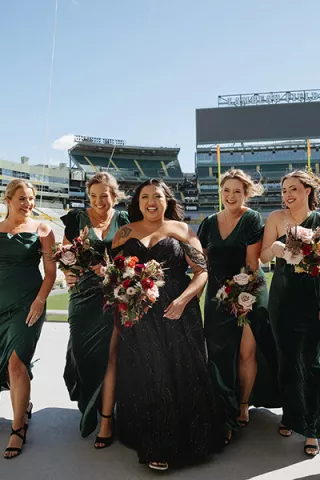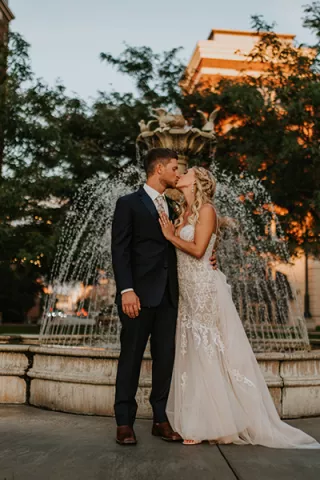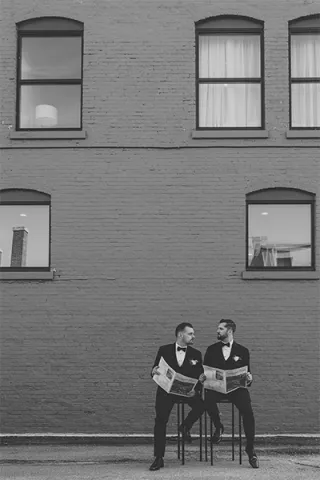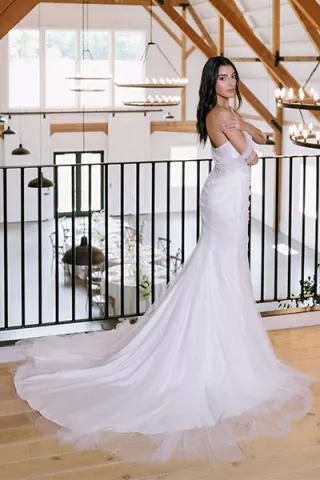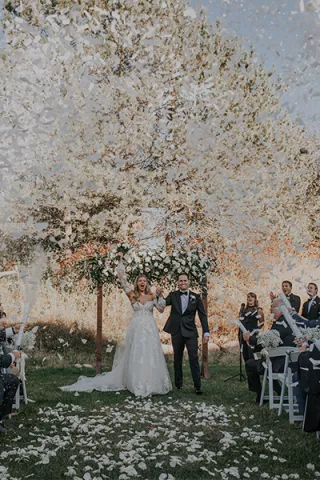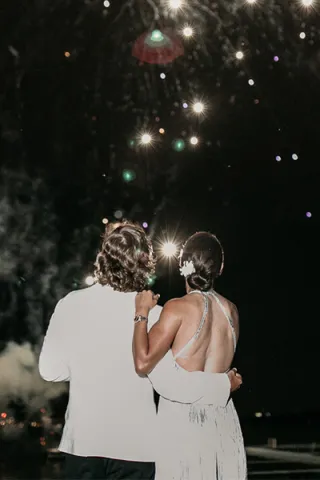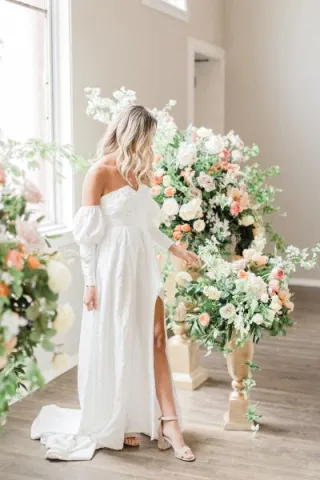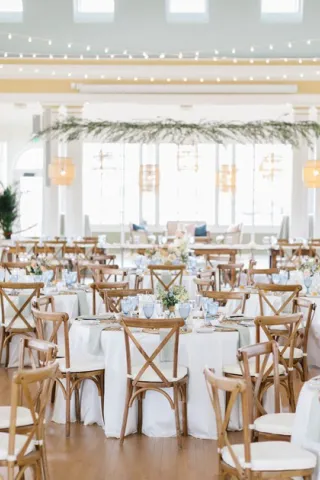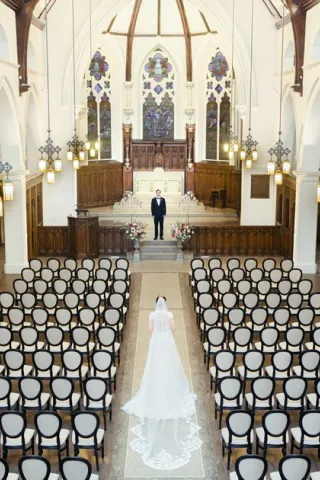The scene: Ferryville, Wis., population 174, snuggled up against the Mississippi River between Prairie Du Chien and LaCrosse. It’s August, ice-meltingly hot and a long way from big-city resources. Could a Chicago account executive and a businessman from Ireland pull off a lavish outdoor wedding here? You bet—but not without a lot of planning, says wedding planner Nancy Flottmeyer, owner of Weddings by Nancy in La Crosse.
In the last few years brides and grooms seem to be gravitating to Wisconsin’s great outdoors for their celebrations. Planners say outdoor settings provide maximum flexibility and creativity, but also require fastidious attention to detail. Although Lindsey Clark and Declan Flanagan lived in Chicago, the bride wanted to come home and be married in her parents’ Ferryville backyard. Yet both wanted a celebration that catered to their sophisticated friends. “It started out on a simpler level, like they all do,” Flottmeyer says. That’s when the work began for Flottmeyer. Everything had to be brought to the site. Flottmeyer rented lined tents and had air conditioning and flooring put in; the bride ordered up a band from Chicago. Meals for the 210 guests had to be prepared on site—its remoteness made shuttling food impossible. The tent company did a site inspection and found the site anything but level: Flooring was installed to cover the undulating ground.
As Flottmeyer advised, the couple had a backup plan (a waterfront ballroom in La Crosse) in case weather frowned on them. A fleet of support staff, from servers, chefs and florists to construction workers and electricians, helped carry off what Flottmeyer says was a “flawless wedding” with one amusing glitch: the August heat melted an ice-carved cow. “It ended up looking like a scrawny lamb because the weather was hot. There are always unforeseen things in outdoor weddings.”
Outdoors Means More Work
Experts agree on one thing: Don’t stage an outdoor wedding because you think it will cost less. “I let couples know that, despite their preconceived notion, an outdoor wedding is rarely the cheapest route,” says wedding planner Angela Dupont, owner of Top Shelf Weddings and Events in Madison. “It’s also a far more difficult option. Everything has to be brought in, arranged, cleaned up and torn down. In every case, outdoor weddings come with a certain amount of risk—weather being the most uncontrollable. Brides and grooms must be willing to accept the stress that comes with that uncertainty.”
Wedding planners, too. Dupont’s stress level went sky high just before guests arrived at an outdoor reception she organized in Spring Green last June. “In the morning, we set up everything inside the tent—linens, specially folded napkins with a blade of grass inserted, chocolate favors, Chiavari chairs, paper lanterns, peonies floating in the pool. The weather was perfect, and everything inside the tent was perfect, so my assistant and I laced up the side walls of the tent and left for the church. That afternoon, a freak summer storm blew in with high winds and hail.” The florist called Dupont from the reception site to tell her the wind had laid waste to the morning’s work. Fortunately, Dupont’s assistant was able to repair the damage and got the candles lit just before the first guest arrived.
Outdoor weddings may not be for the faint of heart, but the possibilities are endless—and very different depending on the setting, says David Caruso, who owns Dynamic Events in Milwaukee. “Each place requires a different set of elements to make it perfect.” Last July, for example, he planned a wedding at a farm in Adell, a town of about 500 in Sheboygan County. Everything was brought to the site, including two large generators, a trash dumpster, an ice machine and a restroom trailer. “It was five days of set-up,” Caruso says. He followed his own best rule for outdoor affairs—he reviewed historical weather reports and discovered that Germanfest, one of Milwaukee’s most popular summer events, was always held on a certain July weekend because it had the highest likelihood of good weather. “The couple chose the weekend of July 25 because that is always historically the best weekend of the summer—and it was. It was perfect.”
More Couples Going Outside
“In the last three years, we’ve seen a lot of growth in the outdoor wedding business,” said Melody Cook of Bucky’s Rentals near Madison, which rents everything from linens, tables and chairs to tents, columns, arches and candelabras. Options range from a small tent that measures 20 feet by 20 feet on grass to a lavish, giant 60-by-180-foot tent, draped in a luxury liner with a port-a-floor, dance floor, formal lighting, gorgeous linens and all the trimmings, says Cook. The company also offers luxurious bathroom trailers with marble sinks, running water, flushing toilets and heating or air conditioning, a new trend in outdoor weddings.
Cook says events can be as simple or as high-end as a couple choose. “You can do all or some of the setting up and decorating … or you can have it all done for you. The possibilities are limited only by budget and imagination.” Average costs: A wedding with a white wedding tent, round tables, white folding chairs, simple white linens, lighting and dance floor for 150 guests would average about $2,500 and up. And that’s not including the tent liner, side walls or French windows, or a floor if the ground is soft or uneven, she says. Bathroom trailers rent for $1,200 a day.
Dupont said decorating is the best part of an outdoor wedding. “Most people go for a more natural theme, to take advantage of the nature all around them. They use the green grass, trees and foliage as their main design element. Others see an outdoor tented wedding as an opportunity to start from scratch. The white ceiling and side walls of a tent are essentially a blank palette.” By contrast, she said, “in an indoor reception, you typically have to work with the existing décor. If the room is dark and antique-looking, but you wanted a clean and modern feel, it’s going to take a lot more creativity and investment in décor to pull that off.”
There are also myriad options for staging, says Caruso. “Often times with outdoor weddings, there’s flexibility in how you use the space. You can create a nice lounge-inspired area for cocktail mixing and mingling in one space, then transition to another for dinner, and then a third place for dancing. This creates a really interactive feeling rather than being in one space for the entire event, which will get very dull very quickly.”
Realize, however, that an outdoor setting can be unforgiving. “A facility such as a hotel or banquet hall won’t be there to cover your bases,” Dupont says. “You have to be concerned about the grounds, restroom facilities, climate control, food and beverage, decorations, rentals (tables, chairs, tent), electricity, lighting. For home weddings, another set of checklists come into play. Can their septic system handle the bathroom traffic? Is there any remodeling that needs to be done, and what are the deadlines? Do they need permits for tent erection, amplified sound or parking in their neighborhood?”
The Ferryville wedding was a model of adaptation. “We had ramps going all over the place,” Flottmeyer says. “The floor was 44 feet by 164 feet—it went from zero to 13 feet off the ground in the back, overlooking the marsh. The bride had this tree she wanted to be a smoking lounge, so we had a ramp going from the back of the tent to the smoking lounge.” The couple loved it, she says. “It was all in the details, all in the details.”
Get more from Wisconsin Bride! Follow us on Twitter and Facebook.

